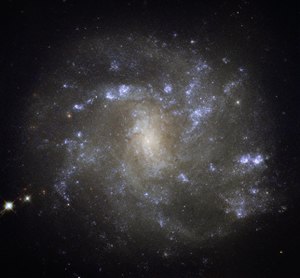| NGC 2500 | |
|---|---|
 NGC 2500 imaged by the Hubble Space Telescope | |
| Observation data (J2000 epoch) | |
| Constellation | Lynx |
| Right ascension | 08h 01m 53.2s [1] |
| Declination | +50° 44′ 14″ [1] |
| Redshift | 0.001715 [1] |
| Heliocentric radial velocity | 514 ± 1 km/s [1] |
| Distance | 33 Mly (10.1 Mpc) [2] |
| Apparent magnitude (V) | 12.2 [1] |
| Characteristics | |
| Type | SB(rs)d [1] |
| Apparent size (V) | 2.9′ × 2.6′ [1] |
| Other designations | |
| UGC 4165, [1] PGC 22525 [1] | |
NGC 2500 is a barred spiral galaxy in the constellation Lynx which was discovered by William Herschel in 1788. Much like the local group in which our own Milky Way galaxy is situated, NGC 2500 is part of the NGC 2841 group of galaxies which also includes NGC 2541, NGC 2537 and NGC 2552. It has a H II nucleus [3] and exhibits a weak inner ring structure.